Related Research Articles


Boscobel House is a Grade II* listed building in the parish of Boscobel in Shropshire. It has been, at various times, a farmhouse, a hunting lodge, and a holiday home; but it is most famous for its role in the escape of Charles II after the Battle of Worcester in 1651. Today it is managed by English Heritage.

Fonthill Gifford is a village and civil parish in Wiltshire, England, to the north of the Nadder valley, 14 miles (23 km) west of Salisbury.
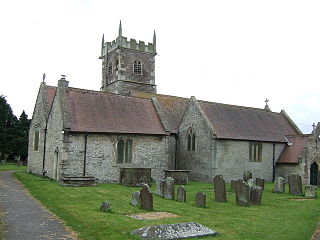
Stoke Gifford is a village and parish in South Gloucestershire, England. It had around 11,000 residents at the 2001 census, increasing to 15,494 at the 2011 census and then to 19,794 in the 2021 Census.
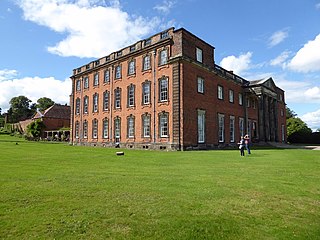
Chillington Hall is a Georgian country house near Brewood, Staffordshire, England, four miles northwest of Wolverhampton. It is the residence of the Giffard family. The Grade I listed house was designed by Francis Smith in 1724 and John Soane in 1785. The park and lake were landscaped by Capability Brown.
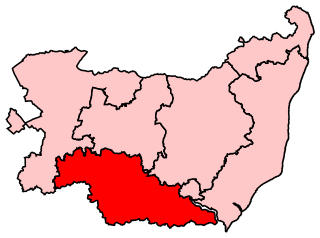
South Suffolk is a constituency represented in the House of Commons of the UK Parliament since 2015 by James Cartlidge, a Conservative.

Crowmarsh Gifford, commonly known as Crowmarsh, is a village in the civil parish of Crowmarsh in South Oxfordshire. It is beside the River Thames opposite the market town of Wallingford, the two linked by Wallingford Bridge. Crowmarsh parish also includes the hamlet of Newnham Murren, which is now merged with the village; the hamlet of Mongewell, and the village of North Stoke 2 miles (3.2 km) to the south.

Gifford is a village in the parish of Yester in East Lothian, Scotland. It lies approximately 4 miles (6.4 km) south of Haddington and 25 miles (40 km) east of Edinburgh.
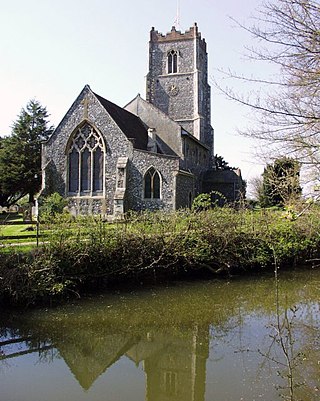
Otley is a village and civil parish in the English county of Suffolk. It is around 7 miles (11 km) north-east of Ipswich in the East Suffolk district. The parish, which covers an area of about 9 square kilometres (3.5 sq mi), had a population of 676 at the 2011 United Kingdom census. The B1079 road runs through the village, meeting the B1078 to the south of the parish at Otley Green.

Yester Castle is a ruined castle, located 1+1⁄2 miles southeast of the village of Gifford in East Lothian, Scotland. The only remaining complete structure is the subterranean Goblin Ha' or Hobgoblin Ha' . It is a Scheduled Ancient Monument, recorded as such by the Royal Commission on the Ancient and Historical Monuments of Scotland.
The first Hugh de Giffard was an influential feudal baron in Scotland, and one of the hostages for the release of King William the Lion in 1174.

Cockfield Hall in Yoxford in Suffolk, England is a Grade I listed private house standing in 76 acres (31 ha) of historic parkland, partly dating from the 16th century. Cockfield Hall takes its name from the Cokefeud Family, established there at the beginning of the 14th century. It was purchased by Jon Hunt in 2014 to form part of his Wilderness Reserve offering exclusive rural holiday accommodation.

Bowers Gifford is a small village and former civil parish, now in the parish of Bowers Gifford and North Benfleet, in the Basildon district, in Essex, England. It is east of Pitsea and west of South Benfleet. It adjoins the small village of North Benfleet.

Wickhambrook is a village and civil parish in the West Suffolk district of Suffolk in eastern England. It is about ten miles (16 km) south-west from Bury St Edmunds, halfway to Haverhill, off the A143 road. Wickhambrook is the largest village by area in the county of Suffolk with a population of 1170 in 2005.
Coltsfoot Green is a small hamlet within the village of Wickhambrook, Suffolk, England. It constitutes one of its eleven village greens and consists of a small green with a small tributary of the River Glem running through it. Until 2009 there was a small copse on the green which was removed due to the poor condition of the trees. Replanting was anticipated in 2010 but the Estates Committee of the Parish Council decided to leave the Green without further planting for the foreseeable future. A water well resided on the green until it was filled in at an unknown date although evidence of its existence was demonstrated when the copse was removed. On the Green is also a memorial bench which looks out over the Green towards Coltsfoot Close.
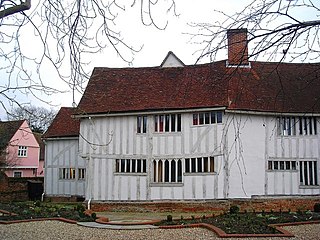
Lavenham Priory is a 13th-century Grade I listed building in Lavenham, Suffolk, England.
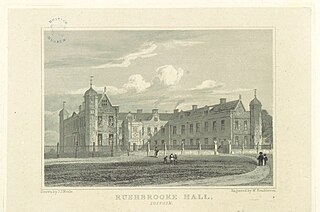
Rushbrooke Hall was a British stately home in Rushbrooke, Suffolk. For several hundred years it was the family seat of the Jermyn family. It was demolished in 1961.

Great Bricett Hall is a grade I listed farmhouse in the village of Great Bricett, Suffolk, England.

Giffords Hall is a Tudor manor house near Stoke-by-Nayland in Suffolk, England. It was described by Nikolaus Pevsner as “one of the loveliest houses of its date in England”. It is one of two houses in Suffolk formerly owned by the Gifford family in the 13th century, the other being Gifford's Hall, Wickhambrook.
Gifford's Hall and Giffords Hall are frequently interchanged names for two historic buildings of similar periods in Suffolk.
References
- ↑ "Gifford's Hall". Historic England . Retrieved 3 February 2023.
- 1 2 Sandon, Eric (1977). Suffolk houses : a study of domestic architecture. Woodbridge [England]: Baron Pub. ISBN 0-902028-68-5.